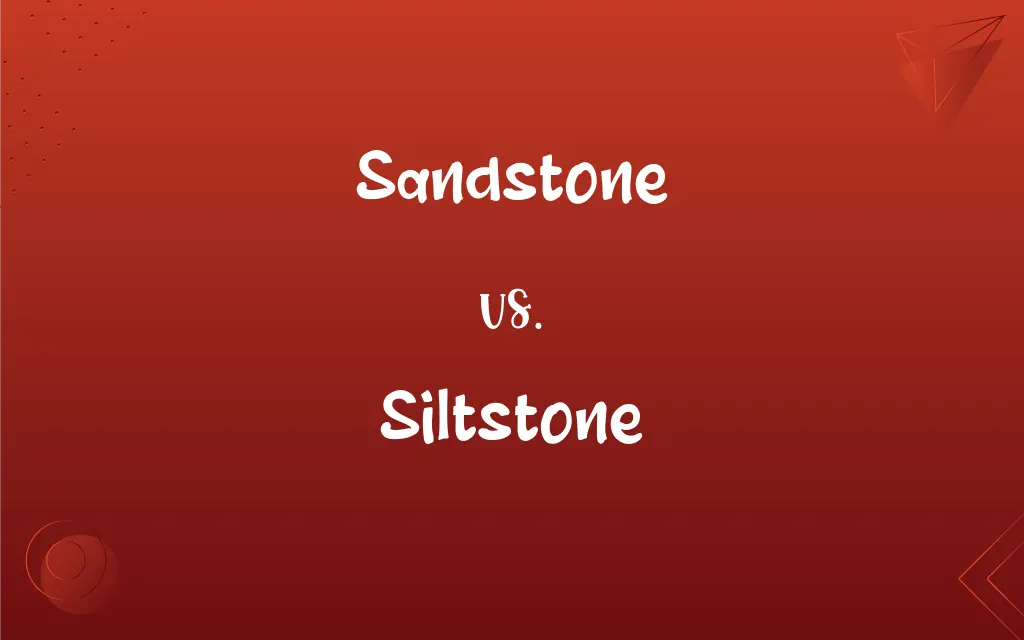Sandstone vs. Siltstone: What's the Difference?
By Aimie Carlson || Updated on May 23, 2024
Sandstone is a sedimentary rock made primarily of sand-sized particles, while siltstone consists of finer, silt-sized particles. Sandstone is coarser and more porous, whereas siltstone is finer-grained and less permeable.

Key Differences
Sandstone is a type of sedimentary rock composed mainly of sand-sized mineral particles or rock fragments. It typically has a gritty texture due to the larger grain size, which ranges from 0.0625 to 2 millimeters. Sandstone is known for its high porosity and permeability, making it a common reservoir for oil, gas, and groundwater. Siltstone, on the other hand, consists primarily of silt-sized particles, which are smaller than sand grains, typically between 0.0039 and 0.0625 millimeters. Siltstone feels smoother than sandstone because of its finer grain size. Its lower porosity and permeability make it less effective as a reservoir rock compared to sandstone.
Sandstone often forms in environments such as beaches, deserts, and riverbeds where high-energy conditions can transport and deposit larger particles. Siltstone forms in lower-energy environments like lakes, river deltas, and floodplains, where finer particles can settle out of suspension.
In terms of color, sandstone can vary widely depending on the mineral composition, often appearing in shades of tan, yellow, red, gray, and white. Siltstone usually exhibits more uniform colors, such as gray, brown, or reddish-brown, reflecting its finer and more homogeneous particle size.
The cementation process also differs; sandstone typically has a more visible cement, like quartz or calcite, binding the grains together. Siltstone's cement is usually less prominent, making the rock appear more cohesive and compact.
While sandstone is extensively used in construction and as a decorative stone due to its durability and aesthetic appeal, siltstone is less commonly used for these purposes. Siltstone is more prone to weathering and erosion, limiting its applications compared to the more robust sandstone.
ADVERTISEMENT
Comparison Chart
Grain Size
Sand-sized particles (0.0625-2 mm)
Silt-sized particles (0.0039-0.0625 mm)
Texture
Gritty
Smooth
Porosity
Higher
Lower
Formation Environment
High-energy (beaches, deserts)
Low-energy (lakes, deltas)
Common Colors
Tan, yellow, red, gray, white
Gray, brown, reddish-brown
ADVERTISEMENT
Sandstone and Siltstone Definitions
Sandstone
A sedimentary rock composed of sand-sized particles.
The cliffs were made of a striking red sandstone.
Siltstone
A sedimentary rock composed of silt-sized particles.
The outcrop revealed layers of dark gray siltstone.
Sandstone
A common reservoir rock for groundwater.
Many aquifers are housed within sandstone formations.
Siltstone
A rock with low porosity and permeability.
Siltstone does not make a good reservoir for oil.
Sandstone
A durable material for paving and sculpture.
The garden paths were lined with sandstone pavers.
Siltstone
A fine-grained rock with a smooth texture.
Siltstone can be easily scratched with a fingernail.
Sandstone
A porous rock often used in construction.
The building's facade was crafted from local sandstone.
Siltstone
A rock type found in low-energy environments.
Siltstone forms in areas like river deltas and floodplains.
Sandstone
A rock type formed in high-energy environments.
Sandstone is often found in ancient desert regions.
Siltstone
A rock prone to weathering and erosion.
The old siltstone wall showed significant erosion over time.
Sandstone
A sedimentary rock formed by the consolidation and compaction of sand and held together by a natural cement, such as silica.
Siltstone
A fine-grained rock of consolidated silt.
Sandstone
A sedimentary rock produced by the consolidation and compaction of sand, cemented with clay etc.
Siltstone
A sedimentary rock whose composition is intermediate in grain size between the coarser sandstone and the finer mudstone.
Sandstone
A rock made of sand more or less firmly united. Common or siliceous sandstone consists mainly of quartz sand.
Siltstone
A fine-grained sandstone of consolidated silt
Sandstone
A sedimentary rock consisting of sand consolidated with some cement (clay or quartz etc.)
FAQs
Where is sandstone commonly formed?
Sandstone typically forms in high-energy environments like beaches and deserts.
What is sandstone?
Sandstone is a sedimentary rock made primarily of sand-sized particles.
What is siltstone?
Siltstone is a sedimentary rock composed of finer silt-sized particles.
Which rock has higher porosity, sandstone or siltstone?
Sandstone generally has higher porosity compared to siltstone.
Where does siltstone typically form?
Siltstone forms in low-energy environments such as lakes and river deltas.
What are common colors of sandstone?
Sandstone can be tan, yellow, red, gray, or white.
Can sandstone be used in construction?
Yes, sandstone is commonly used in construction and decorative works.
How does sandstone differ from siltstone in grain size?
Sandstone has larger, sand-sized grains, while siltstone has much finer, silt-sized grains.
What is the texture of sandstone?
Sandstone has a gritty texture due to its larger grain size.
What is the texture of siltstone?
Siltstone has a smooth texture because of its finer grains.
How does the cementation process differ between sandstone and siltstone?
Sandstone typically has more visible cementation like quartz or calcite, while siltstone's cementation is less prominent.
Is siltstone commonly used for construction?
Siltstone is less commonly used in construction due to its tendency to weather and erode.
What colors are typical for siltstone?
Siltstone is usually gray, brown, or reddish-brown.
What environments favor the formation of sandstone?
Sandstone forms in high-energy environments.
What is the durability comparison between sandstone and siltstone?
Sandstone is generally more durable than siltstone.
Which rock is a better reservoir for groundwater, sandstone or siltstone?
Sandstone is a better reservoir for groundwater.
What environments favor the formation of siltstone?
Siltstone forms in low-energy environments.
Which rock has a smoother feel, sandstone or siltstone?
Siltstone has a smoother feel compared to sandstone.
Which rock is more porous, sandstone or siltstone?
Sandstone is more porous than siltstone.
Why is sandstone more commonly used in construction compared to siltstone?
Sandstone's durability and aesthetic appeal make it more suitable for construction than the less durable siltstone.
About Author
Written by
Aimie CarlsonAimie Carlson, holding a master's degree in English literature, is a fervent English language enthusiast. She lends her writing talents to Difference Wiki, a prominent website that specializes in comparisons, offering readers insightful analyses that both captivate and inform.































































